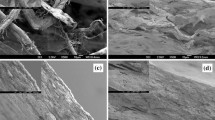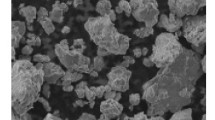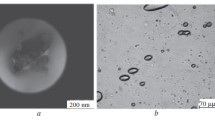Abstract
This work describes the partial oxypropylation of filter paper cellulose fibers, employing two different basic catalyst, viz., potassium hydroxide and 1,4-diazabicyclo [2.2.2] octane, to activate the hydroxyl groups of the polysaccharide and thus provide the anionic initiation sites for the “grafting-from” polymerization of propylene oxide. The success of this chemical modification was assessed by FTIR spectroscopy, X-ray diffraction, scanning electron microscopy, differential scanning calorimetry, thermogravimetric analysis and contact angle measurements. The study of the role of the catalyst employed on the extent of the modification and on the mechanical properties of the ensuing composites, after hot pressing, showed that both the Brønsted and the Lewis base gave satisfactory results, without any marked difference.
Similar content being viewed by others
Explore related subjects
Discover the latest articles, news and stories from top researchers in related subjects.Avoid common mistakes on your manuscript.
Introduction
In recent years, numerous studies about the preparation and properties of composite materials reinforced with cellulose fibers have been carried out and comprehensive reviews published (Belgacem and Gandini 2005, 2008a, b; Dufresne 2008). Compared with glass or carbon fibers used conventionally, cellulose fibers, which are renewable resources, have several other advantages including low density, ubiquitous availability (albeit from different vegetable species) recyclability, and low cost, while preserving good mechanical properties. Most of the investigations carried out in recent years have concentrated on the surface physical or chemical modification of these fibers in order to optimize their interfacial behavior with different macromolecular matrices (polyolefins, polyesters, etc.), i.e., to obtain composites with the best mechanical performance.
A different and perhaps more original strategy to exploit these fibers has consisted in preparing composite materials entirely derived from them, whether through mixtures of cellulose fibers within a cellulose matrix (Gindl and Keckes 2005, 2007; Nishino et al. 2004; Nishino and Arimoto 2007; Pommet et al. 2008; Qin et al. 2008; Soykeabkaew et al. 2008), or through the generation of a thermoplastic cellulose shell which can be turned into a matrix by hot pressing, while the pristine inner core of the fibers is retained to function as the reinforcing element (Mutsumura et al. 2000; Mutsumura and Glasser 2000; Lu et al. 2003, 2004a, b; Zhang et al. 2005; Gandini et al. 2005; Freire et al. 2006, 2008; de Menezes et al. 2007).
We tackled this second approach through the partial oxypropylation of the fibers and reported succinctly on the preliminary successful results (Gandini et al. 2005). This investigation has now progressed qualitatively and quantitatively and we wish to report here the results related to the role of the oxypropylation catalyst on the performance of the systems. The influence of the nature of both natural and regenerated cellulose fibers on this process has been reported elsewhere (de Menezes et al. 2008).
Experimental
Oxypropylation process
The cellulose substrate used in this work was Filter Paper (FP) (Hexis). The procedure for its partial oxypropylation consisted in impregnating ~2 g of FP with an ethanol/catalyst solution [(catalyst)/(cellulose OH) ~0.1] which was then left for ~12 h before evaporating the ethanol. The basic catalysts used were a Brønsted base, KOH, and a Lewis base, 1,4-diazabicyclo [2.2.2] octane (DABCO). Thereafter, the thus activated cellulose was soaked with commercial propylene oxide (PO, ACROS) under nitrogen in a 100 mL stainless steel autoclave. The variables explored in these reactions were the catalyst employed and the [PO]/[cellulose OH] molar ratio, viz. 1, 3 and 5, and the corresponding oxypropylated samples were identified as PO1, PO3 and PO5. The quantity of PO and cellulose employed in the experiments were calculated considering that cellulose is composed of anhydrous glucose units, whose molar weight is 162 g mol−1, and that each unit bears three hydroxyl groups.
The closed autoclave, equipped with a manometer, a calibrated temperature measuring thermocouple and a controlled heating system, was then heated to the desired temperature (135 °C), while monitoring the corresponding pressure increase. In some systems, the onset of the oxypropylation reaction was revealed by an increase in both temperature and pressure, because the exothermic character of the PO polymerization was initially more important than the depletion of the gaseous monomer, and its final stage was associated with the system returning to atmospheric pressure, indicating the total consumption of PO. Since in some instances the reaction was too slow to generate a detectable temperature increase, the reaction time became the relevant parameter in terms of the extent of PO conversion.
At the end of all the reaction, the autoclave was allowed to return to room temperature before opening it and removing the ensuing materials which were then submitted to a soxhlet extraction with n-hexane in order to remove the PO homopolymer (PPO) accompanying the oxypropylated fibers (Pavier and Gandini 2000). This operation was carried out with the specific purpose of assessing the behavior of the different systems tested in terms of relative contribution of both reactions, but was not necessary in the context of the actual use of the composites, since we found that modest amounts of PPO did not modify their basic features.
The materials obtained were characterized by weight gain, content of PO homopolymer, and the additional techniques described below.
Fourier transformed infrared (FTIR) spectra were recorded in KBr pellets (1:100 w/w) with a BOMEN-MB102 spectrometer.
X-ray diffraction (XRD) diffractograms were recorded with a Carl-Zeis-Jena–UDR6 diffractometer. The scattered radiation was detected in the angular range of 5–40° (2θ) at a speed of 2° min−1. The crystallinity index (CI) was estimated by the height ratio between the diffraction peaks in I CR (2θ = 22–23° for cellulose type I and 2θ = 18–22° for cellulose type II) for the crystalline phase, and I AM (2θ = 18–19° for cellulose type I and 2θ = 13–15° for cellulose type II) for the amorphous counterpart. This approach was utilized considering two-phase models for these materials (Hermans and Weidinger 1948, 1949, 1951; Thygesen et al. 2005), using the standard relationship
Differential scanning calorimetry (DSC) thermograms were obtained in a nitrogen atmosphere using a Shimadzu-TA-50WSI analyzer at a scanning rate of 10 °C min−1 between −100 and 180 °C.
Thermogravimetric Analyses (TGA) were conducted in a nitrogen atmosphere with a Shimadzu-TA-50 analyzer, working in the temperature range of 25–1,000 °C and a heating rate of 20 °C min−1.
Contact angle measurements were carried out with an OCA-Dataphysics Contact Angle System using four liquids of very different polarity, viz. water, ethylene glycol, formamide, and diiodomethane. The dispersive and polar contributions to the surface energy of each tested sample were obtained using the approach proposed by Owens and Wendt (1969).
Scanning electron microscopy (SEM) images were obtained with a Leo Scanning Electron Microscope.
Mechanical tests of the hot pressed films (3 min at 135 °C and a pressure of 5 T) were performed using a DMA 2,980—TA instrument. For stress–strain measurements the following conditions were applied: pre-load force 0.5 N and stretching rate 0.5 N min−1. Typical samples dimensions were ~0.15 × 10 × 5 mm (thickness × length × width).
Results and discussion
As expected, all the products extracted with n-hexane displayed the typical FTIR, DSC and 1H NMR features of polypropylene oxide macrodiols (data no reported here). Figure 1 shows the FTIR spectra of the materials before (FP) and after the oxypropylation with [PO]/[cellulose OH] molar ratios 1, 3 and 5 (FPPO1, FPPO3 and FPPO5), catalyzed by each base, and after the removal of the PO homopolymer. The relevant features that can be observed are the overall absorption increase in the aliphatic CH stretching region (2,800–3,000 cm−1), with the appearance of a new peak around 2,970 cm−1, associated with the methyl groups of the grafted propylene oxide units; the increase and shift of absorption in the C–O stretching region (1,000–1,100 cm−1), associated with the ether moieties borne by those units, and the new peak at 1,380 cm−1, which confirmed the presence of the CH3 groups. As expected, these features were the more pronounced, the higher the [PO]/[cellulose OH] molar ratio.
Table 1 gives the weight gains for all the oxypropylated and extracted samples. The nature of the basic catalyst used did not influence this parameter, suggesting that both displayed a similar activity.
Figure 2 shows the X-ray diffractograms of all the modified fibers compared with that of the pristine filter paper. The calculated values of the crystallinity index (CI) are given in Table 1. The changes in the X-ray pattern subsequent to the oxypropylation reaction were attributed to the transformation of the portion of the original cellulose to the corresponding amorphous oxypropylated derivative. The use of KOH in conjunction with the highest [PO]/[cellulose OH] molar ratio, PO5, was found to be too aggressive in terms of this transformation. In all other experiments, it appears that the amorphous microphases of the initial cellulose fibers were predominantly responsible for the oxypropylation, given the negligible-to-small decrease in CI. The question of the preferential sites of oxypropylation deserves some comments. Two factors are relevant here, viz. on the one hand, the well known preferential reactivity of the cellulose primary hydroxyl groups, and on the other hand, the fact that the amorphous microphases (cellulose II) of this substrate are obviously more prone to be modified than their crystalline counterparts (cellulose I), as clearly shown by the X-ray patterns (Fig. 2) and the corresponding variations in the CI values.
The thermal stability of the cellulose samples before and after the different reactions is shown in Fig. 3. The first mass loss, observed from room temperature to 130 °C, reflected the typical residual moisture evaporation. The actual thermal decomposition temperatures was taken as that following, 2% weight loss (Table 2). These results showed a decrease in these temperatures associated with all the oxypropylation reactions, but with erratic variations in the actual extent of this thermal fragilization. This issue is not readily explained and is being pursued further.
The DSC thermograms of all the materials are shown in Fig. 4. Apart from the expected absence of a Tg feature for the pristine filter paper, all the other samples gave values comprised between −55 and −45 °C, compared with the Tg of the isolated PPO which was about −60 °C. This behavior was already observed with different polysaccharides grafted with PPO chains (Schoenenberger et al. 1995; Velazquez-Morales et al. 1998; Gandini et al. 2005; de Menezes et al. 2007, 2008) and has been interpreted as reflecting the glass transition of the appended polyether chains (i.e., somewhat less mobile than free ones), without any substantial contribution from the polysaccharide trunk macromolecules.
The surface energy (γ S) values, calculated from the contact angle measurements with the four test liquids, are shown in Table 3. The decrease in polar contribution (\( \gamma_{\text{S}}^{\text{p}} \)) was systematic, reflecting the presence of the less polar PPO grafts on the samples’ surface, but was much more marked in the case of samples oxypropylated in the presence of DABCO. The corresponding dispersive contributions (\( \gamma_{\text{S}}^{\text{d}} \)) did not show any consistent variation, as expected for a polymeric substrate.
The SEM micrographs of the FP cellulose fibers before and after oxypropylation with both catalysts (Fig. 5) showed the progressive build-up of a thermoplastic sleeve around the fibers, as the [PO]/[cellulose OH] molar ratio was increased. Figure 6 displays the typical morphology obtained after hot pressing these oxypropylated substrate, with clear evidence of the thermoplastic matrix formation around the unmodified inner core of the fibers.
The values obtained in the stress–strain tests are shown in Table 4. The most relevant features here are (1) the progressive increase in the elongation at break as a function of the extent of oxypropylation, and (2) the corresponding decrease in the elastic modulus, both associated with the growing contribution of the thermoplastic component.
Conclusions
This investigation confirmed the interest in preparing self-reinforced composite materials by the partial oxypropylation of cellulose fibers through a systematic approach involving two different catalysts and a thorough characterization of the ensuing materials, including the mechanical properties of their hot pressed films. It moreover showed that both Brønsted and Lewis bases are very efficient catalysts for the process, although it is premature to assess which of them is the better activator. The upscaling of the oxypropylation process does not introduce any difficulty (Pavier 1998) and is economically viable when applied to cheap substrates, so that the materials described here are technologically viable. Indeed, work is in progress in the Aveiro laboratory to build a pilot equipment to that effect.
References
Belgacem MN, Gandini A (2005) The surface modification of cellulose fibres for use as reinforcing elements in composite materials. Compos Interfaces 12:41–75. doi:10.1163/1568554053542188
Belgacem MN, Gandini A (2008a) Surface modification of cellulose fibres. In: Belgacem MN, Gandini A (eds) Monomers polymers and composites from renewable resources. Elsevier, Oxford, pp 385–400
Belgacem MN, Gandini A (2008b) Natural fibre surface modification and characterization. In: Thomas S, Pothan L (eds) Cellulose-fiber reinforced polymer composites. Old City Publishing, Philadelphia (in press)
de Menezes AJ, Pasquini D, Curvelo AAS, Gandini A (2007) Novel thermoplastic materials based on the outer-shell oxypropylation of corn starch granules. Biomacromolecules 8:2047–2050. doi:10.1021/bm070389j
de Menezes AJ, Pasquini D, Curvelo AAS, Gandini A (2008) Self-reinforced composites obtained by the partial oxypropylation of cellulose fibers. 1. Characterization of the materials obtained with different types of fibers. Carbohydr Polym (submitted)
Dufresne A (2008) Cellulose-based composites and nanocomposites. In: Belgacem MN, Gandini A (eds) Monomers polymers and composites from renewable resources. Elsevier, Oxford, pp 401–418
Freire CSR, Silvestre AJD, Neto CP, Belgacem MN, Gandini A (2006) Controlled heterogeneous modification of cellulose fibers with fatty acids: effect of reaction conditions on the extent of esterification and fiber properties. J Appl Polym Sci 100:1093–1102. doi:10.1002/app.23454
Freire CSR, Silvestre AJD, Neto CP, Gandini A, Martin L, Mondragon I (2008) Composites based on acylated cellulose fibers and low-density polyethylene: effect of the fiber content, degree of substitution and fatty acid chain length on final properties. Compos Sci Technol 68:3358–3364. doi:10.1016/j.compscitech.2008.09.008
Gandini A, Curvelo AAS, Pasquini D, de Menezes AJ (2005) Direct transformation of cellulose fibres into self-reinforced composites by partial oxypropylation. Polymer (Guildf) 46:10611–10613. doi:10.1016/j.polymer.2005.09.004
Gindl W, Keckes J (2005) All-cellulose nanocomposite. Polymer (Guildf) 46:10221–10225. doi:10.1016/j.polymer.2005.08.040
Gindl W, Keckes J (2007) Drawing of self-reinforced cellulose films. J Appl Polym Sci 103:2703–2708. doi:10.1002/app.25434
Hermans PH, Weidinger A (1948) Quantitative X-ray investigations on the crystallinity of cellulose fibers—a background analysis. J Appl Phys 19:491–506. doi:10.1063/1.1698162
Hermans PH, Weidinger A (1949) X-ray studies on the crystallinity of cellulose. J Polym Sci 4:135–144. doi:10.1002/pol.1949.120040203
Hermans PH, Weidinger A (1951) Crystallinity of celluloses after treatment with sodium hydroxide (mercerization). J Polym Sci 6:533–538. doi:10.1002/pol.1951.120060503
Lu X, Zhang MQ, Rong MZ, Shi G, Yang GC (2003) Self-reinforced melt processable composites of sisal. Compos Sci Technol 63:177–186. doi:10.1016/S0266-3538(02)00204-X
Lu X, Zhang MQ, Rong MZ, Yue DL, Yang GC (2004a) Environmental degradability of self-reinforced composites made from sisal. Compos Sci Technol 64:1301–1310. doi:10.1016/j.compscitech.2003.10.013
Lu X, Zhang MQ, Rong MZ, Yue DL, Yang GC (2004b) The preparation of self-reinforced sisal fiber composites. Polym Polym Compos 12:297–307
Mutsumura H, Glasser WG (2000) Cellulosic nanocomposites II. Studies by atomic force microscopy. J Appl Polym Sci 78:2254–2261. doi:10.1002/1097-4628(20001220)78:13<2254::AID-APP30>3.0.CO;2-#
Mutsumura H, Sugiyama J, Glasser WG (2000) Cellulosic nanocomposites I. Thermally deformable cellulose hexanoates from heterogeneous reaction. J Appl Polym Sci 78:2242–2253. doi:10.1002/1097-4628(20001220)78:13<2242::AID-APP20>3.0.CO;2-5
Nishino T, Arimoto N (2007) All-cellulose composite prepared by selective dissolving of fiber surface. Biomacromolecules 8:2712–2716. doi:10.1021/bm0703416
Nishino T, Matsuda I, Hirao K (2004) All cellulose composite. Macromolecules 37:7683–7687. doi:10.1021/ma049300h
Owens DK, Wendt RC (1969) Estimation of the surface free energy of polymers. J Appl Polym Sci 13:1741–1747. doi:10.1002/app.1969.070130815
Pavier C (1998) Doctorate Thesis, Grenoble National Polytechnic Institute
Pavier C, Gandini A (2000) Oxypropylation of sugar beet pulp. 2. Separation of the grafted pulp from the propylene oxide homopolymer. Carbohydr Polym 42:13–17. doi:10.1016/S0144-8617(99)00124-1
Pommet M, Juntaro J, Heng JYY, Mantalaris A, Lee AF, Wilson K, Kalinka G, Shaffer MSP, Bismarck A (2008) Surface modification of natural fibers using bacteria: depositing bacterial cellulose onto natural fibers to create hierarchical fiber reinforcement nanocomposites. Biomacromolecules 9:1643–1651. doi:10.1021/bm800169g
Qin C, Soykeabkaew N, Xiuyuan N, Peijs T (2008) The effect of fibre volume fraction and mercerization on the properties of all-cellulose composites. Carbohydr Polym 71:458–467. doi:10.1016/j.carbpol.2007.06.019
Schoenenberger C, Le Nest JF, Gandini A (1995) Polymer electrolytes based on modified polysaccharides. 2. Polyether-modified cellulosics. Electrochim Acta 40:2281–2284. doi:10.1016/0013-4686(95)00178-H
Soykeabkaew N, Arimoto N, Nishino T, Peijs T (2008) All-cellulose composites by surface selective dissolution of aligned ligno-cellulosic fibres. Compos Sci Technol 68:2201–2207. doi:10.1016/j.compscitech.2008.03.023
Thygesen A, Oddershede J, Lilholt H, Thomsen AB, Stahl K (2005) On the determination of crystallinity and cellulose content in plant fibers. Cellulose 12:563–576. doi:10.1007/s10570-005-9001-8
Velazquez-Morales P, Le Nest JF, Gandini A (1998) Polymer electrolytes derived from chitosan/polyether networks. Electrochim Acta 43:1275–1279. doi:10.1016/S0013-4686(97)10030-5
Zhang MQ, Rong MZ, Lu X (2005) Fully biodegradable natural fiber composites from renewable resources: all-plant fiber composites. Compos Sci Technol 65:2514–2525. doi:10.1016/j.compscitech.2005.06.018
Acknowledgments
The authors thank FAPESP and CAPES (Brazil) for financial support.
Author information
Authors and Affiliations
Corresponding author
Rights and permissions
About this article
Cite this article
de Menezes, A.J., Pasquini, D., Curvelo, A.A.d.S. et al. Self-reinforced composites obtained by the partial oxypropylation of cellulose fibers. 2. Effect of catalyst on the mechanical and dynamic mechanical properties. Cellulose 16, 239–246 (2009). https://doi.org/10.1007/s10570-008-9271-z
Received:
Accepted:
Published:
Issue Date:
DOI: https://doi.org/10.1007/s10570-008-9271-z










